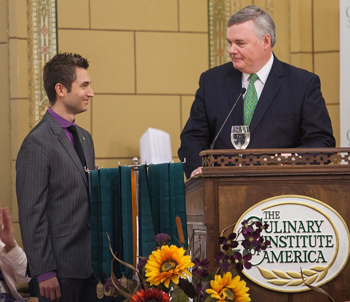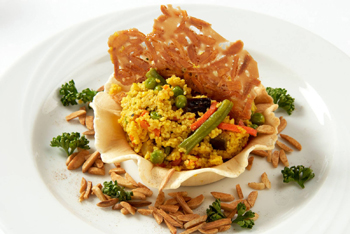Chefs Speak Out: A Modern Approach to Preserving the Past
Monday, 09 December 2013 13:24
 Through the free videos he helps produce for Unilever, Steve Jilleba stresses the need among current and future cooks to understand culinary origins and the impulses that inspired authentic flavors around the globe.
Through the free videos he helps produce for Unilever, Steve Jilleba stresses the need among current and future cooks to understand culinary origins and the impulses that inspired authentic flavors around the globe.
By Lynn Schwartz
“Today, everything moves quickly. There is a lot of cross-culturalization, and culinary traditions get mixed and blended,” says Steve Jilleba, CMC, corporate executive chef for Lisle, Ill.-based Unilever Food Solutions. “Original recipes and cooking techniques can become lost forever.”
The risk of unrecoverable culinary practices inspired Unilever and The Culinary Institute of America to partner in a preservation initiative, The World Culinary Arts DVD & Internet Project. “Savoring the Best of World Flavors” is an interactive series that provides a first-of-its-kind video reference library for future generations, documenting and conserving best culinary practices worldwide.
To date, this ambitious undertaking offers seven volumes featuring more than 16 countries including India, China, Japan, Vietnam, Greece, Sicily, Spain, Mexico, Peru and Brazil. “We are trying to preserve a country’s authenic culinary traditions,” says Jilleba.
To accomplish that, Jilleba and his team travel to a specific country and film the “experts” as they prepare time-honored recipes, divulge necessary ingredients and reveal cooking techniques. The interviews often discuss the dish’s development, geographic and historical implications, and examine how a dish has evolved in contemporary kitchens. The camera also catches visits to a variety of open-air street markets and long-standing food shops. The result is that the viewer, comfortably transported far and wide to each locale, is privy to a country’s past, present and future food culture—something most chefs would never have the opportunity to witness on such a large scale. The videos and podcasts are free of charge to foodservice professionals and students, and many of the recipes are available to download.

 Alex Stupak returns to his alma mater to deliver a commencement address, citing Grant Achatz and Ken Oringer as role models.
Alex Stupak returns to his alma mater to deliver a commencement address, citing Grant Achatz and Ken Oringer as role models. Marco Chirico, at only 25, is already moving a legacy into the next generation via his father’s restaurants—one operating for three decades and one a few years young—in Brooklyn.
Marco Chirico, at only 25, is already moving a legacy into the next generation via his father’s restaurants—one operating for three decades and one a few years young—in Brooklyn. Paladar Latin Kitchen & Rum Bar honors the diversity of South and Central America and the Caribbean by representing several regions on the menu, overseen by executive chef Joseph Tis. Although applications and flavors are authentic, the menu must have broad appeal. After all, just what does Latin food really mean?
Paladar Latin Kitchen & Rum Bar honors the diversity of South and Central America and the Caribbean by representing several regions on the menu, overseen by executive chef Joseph Tis. Although applications and flavors are authentic, the menu must have broad appeal. After all, just what does Latin food really mean? Pittsburgh’s Jeff Sinciline helps Bayer Corporation develop a menu for employees worldwide to enjoy a celebratory lunch marking the company’s 150th anniversary.
Pittsburgh’s Jeff Sinciline helps Bayer Corporation develop a menu for employees worldwide to enjoy a celebratory lunch marking the company’s 150th anniversary.